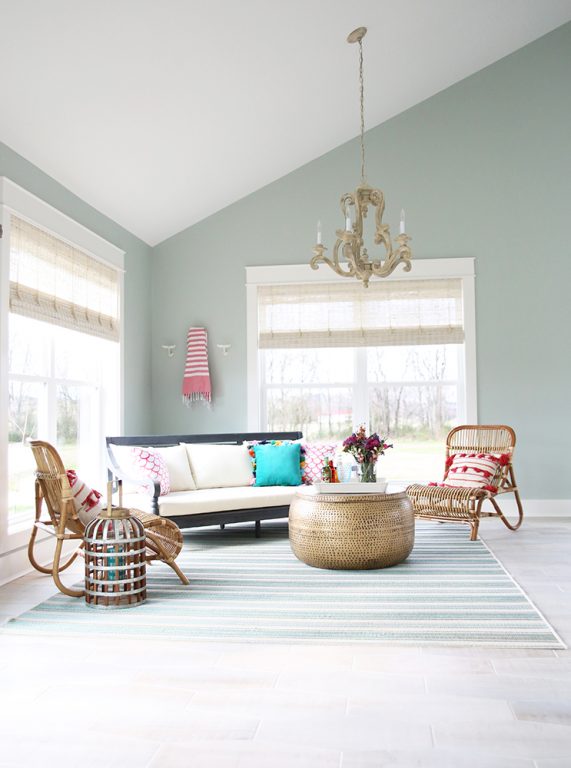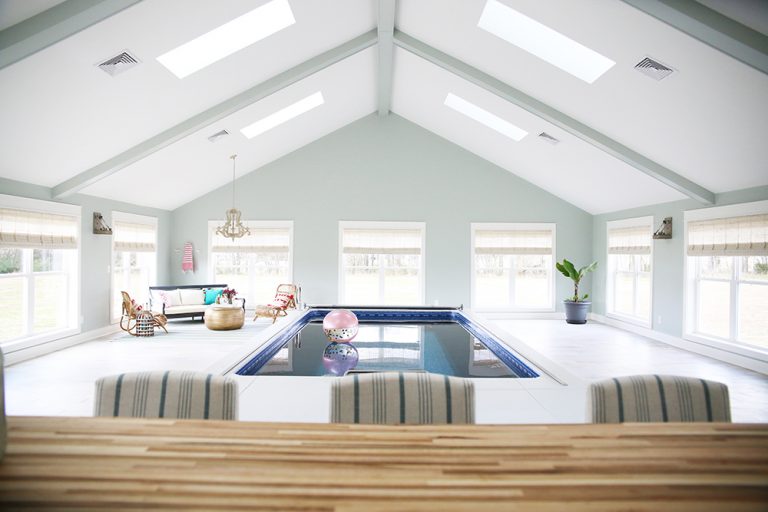Mixing Tiles Patterns: An Indoor Tile Oasis
Posted May 28, 2019Hello to all the fabulous Jeffrey Court readers! We’re Jamin and Ashley Mills of The Handmade Home, and we’re absolutely thrilled to share this pool house project with all of you! Today, we’ll be walking you through how mixing tile patterns can add depth and uniformity to any room.
The project is complete, and it’s been so much fun to share the finished project. But the most gratifying experience was seeing the look on our amazing client’s face when it was said and done! A true retreat was created for her and we were honored to be a part of it.
We receive a lot of questions about how tile comes into play with a great, versatile space like this. And today, we wanted to chat about three main elements that truly influence the design and how it all comes together.
So without further ado…

Trust the Process… Of Choosing the Right Tile
Tile considerations for the project were real factors with this finished pool house. Our main concern was addressing our client’s needs for safety and low maintenance while also offering stylish finds that would affect the final look. Mixing tile patterns were part of what made this renovation so amazing.
The two main questions we receive a lot are:
1) Where do I start in my renovation?
2) How do you make multiple tiles work in one area?

When laying out different tile patterns together, there are a few things we love to consider, but we always start with a piece that you love. Plain and simple.
If you’ve checked it out, you’ll notice we chose the main floor tile, the tile behind the bar and surrounding the endless pool. These were three tile areas that needed to work well together and would also complement the entire room.

Our client Barbara immediately fell in love with Oakwood Lilly and it’s elegant hexagon pattern for her floor tile. From her favorite choice, we were able to start figuring out what wall and bar tile to use.
We chose Allegro White wall tile in a simple subway pattern to complement the flooring around the pool. For the bar backsplash, we used Allegro White Fan tile because the unique shape was a wow factor. We just loved the way it added a nautical “feel” to the pool house!
To break it down, we chose one main tile with simple lines, then built upon it from there with one geometric piece for the flooring, and the behind-the-bar tile as an organic shape to pull it all together.

Form Versus Function
It’s the age-old adage with which came first, form or function? Or at least when it comes to all things tile, this was an important element for the pool house.
When we were designing the room with Barbara, we knew that we had to be very careful about mixing tile patterns. Not only did they have to look great together but they had to function well too. This is where Jeffrey Court’s Oakwood Lilly came in as a great starting point and is a classic example of carefully choosing your finish based on what’s essential for the project.

We presented our client with flooring choices for the pool house with her safety requirements. Using that information, the main floor tile provided both traction when wet and covered the building’s vast floor size.
Another requirement the client had for such a large space was minimizing the grout lines. This did multiple things: it kept the design simple, maintenance low, and also helped with installation costs. Oakwood Lilly’s elongated hexagon shape was a great tile for her flooring choice and an excellent springboard for the rest of the design since it had to cover a lot of ground in the pool house.

From there, we were able to build on that with classics like Jeffrey Court’s Allegro White field tile surrounding the pool for low maintenance and simple lines while using Allegro White Fan tile behind-the-bar. Both tiles play nicely with the floor tile from a design standpoint, but meet her needs in practical ways too.
They’re low maintenance, easy to clean up, and provided simple lines throughout the pool house. This is the perfect example of form versus function with tile choices that always had the client in mind and go beyond just a pretty space.

Low Maintenance Tiles by Design
We touched on this a little above, but a big part of what makes Jeffrey Court’s tile so appealing is the maintenance behind it all. These choices were successful for the project because it’s not something you have to babysit after the install.
Honestly, who has time for that?

In terms of form and function, we seriously considered how Barbara could maintain the space long after we were gone.

The low maintenance nature of these tiles was a win for the client because it isn’t something she has to think about day in and day out.
With a simple mop up, the floors are easily cleaned and could even disguise things that they need to hide in the meantime. The tiles surrounding the pool withstand moisture, and we love the way they added a little sparkle around the edges for an extra touch.
Finally, the Allegro White Fan tile behind the bar cleans up easily with a plain wipe down. And since the bar would have the lowest traffic compared to the other two tile areas, it’s not something she’ll have to worry about in the future.
It makes sense within the pool house to add useful, low maintenance, beautiful finishes to last a very long time. Serenity in beautiful finishes with low maintenance is a definite win in our book.

We hope diving in (pun intended) with a deeper look at mixing tile patterns is helpful when considering how, why, and which tile combinations could work on your next project!
As always, let us know if you have any questions. We’re more than happy to answer any that you may have! Be sure to tag @JeffreyCourtHD and #JeffreyCourtQA, and your questions just might be answered in a special edition of Jeffery Court’s Designer Coffee Chats.
Have an inspired day!





